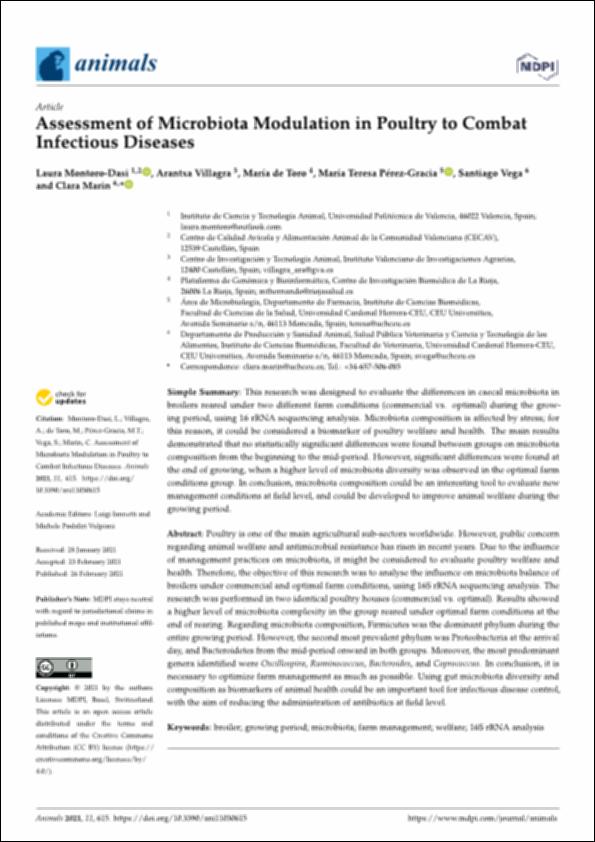Please use this identifier to cite or link to this item:
http://hdl.handle.net/10637/13461Assessment of microbiota modulation in poultry to combat infectious diseases
| Title: | Assessment of microbiota modulation in poultry to combat infectious diseases |
| Authors : | Montoro Dasí, Laura Villagrá García, Aránzazu Toro Hernando, María de Pérez Gracia, María Teresa. Vega García, Santiago Marín Orenga, Clara |
| Keywords: | Aves de corral - Enfermedades infecciosas.; Poultry - Communicable diseases.; Gallinas - Cría y explotación.; Hens - Breeding.; Granjas avícolas.; Microorganismos.; Animal welfare.; Bienestar animal.; ARN - Análisis.; RNA - Analysis.; Microorganisms.; Poultry hatcheries. |
| Publisher: | MDPI |
| Citation: | Montoro-Dasi, L., Villagra, A., de Toro, M., Pérez-Gracia, M. T., Vega, S. & Marin, C. (2021). Assessment of microbiota modulation in poultry to combat infectious diseases. Animals, vol. 11, i. 3 (26 feb.), art. 615. DOI: https://doi.org/10.3390/ani11030615 |
| Abstract: | Poultry is one of the main agricultural sub-sectors worldwide. However, public concern regarding animal welfare and antimicrobial resistance has risen in recent years. Due to the influence of management practices on microbiota, it might be considered to evaluate poultry welfare and health. Therefore, the objective of this research was to analyse the influence on microbiota balance of broilers under commercial and optimal farm conditions, using 16S rRNA sequencing analysis. The research was performed in two identical poultry houses (commercial vs. optimal). Results showed a higher level of microbiota complexity in the group reared under optimal farm conditions at the end of rearing. Regarding microbiota composition, Firmicutes was the dominant phylum during the entire growing period. However, the second most prevalent phylum was Proteobacteria at the arrival day, and Bacteroidetes from the mid-period onward in both groups. Moreover, the most predominant genera identified were Oscillospira, Ruminococcus, Bacteroides, and Coprococcus. In conclusion, it is necessary to optimize farm management as much as possible. Using gut microbiota diversity and composition as biomarkers of animal health could be an important tool for infectious disease control, with the aim of reducing the administration of antibiotics at field level. |
| Description: | Este artículo se encuentra disponible en la siguiente URL: https://www.mdpi.com/2076-2615/11/3/615 Este artículo pertenece al número especial "Animal Welfare, Food Safety and Environmental Sustainability: Farm Animals Productions in a “One-Health” Perspective". |
| URI: | http://hdl.handle.net/10637/13461 |
| Rights : | http://creativecommons.org/licenses/by/4.0/deed.es |
| ISSN: | 2076-2615 (Electrónico) |
| Issue Date: | 5-Mar-2022 |
| Center : | Universidad Cardenal Herrera-CEU |
| Appears in Collections: | Dpto. Producción y Sanidad Animal, Salud Pública Veterinaria y Ciencia y Tecnología de los Alimentos |
Items in DSpace are protected by copyright, with all rights reserved, unless otherwise indicated.


